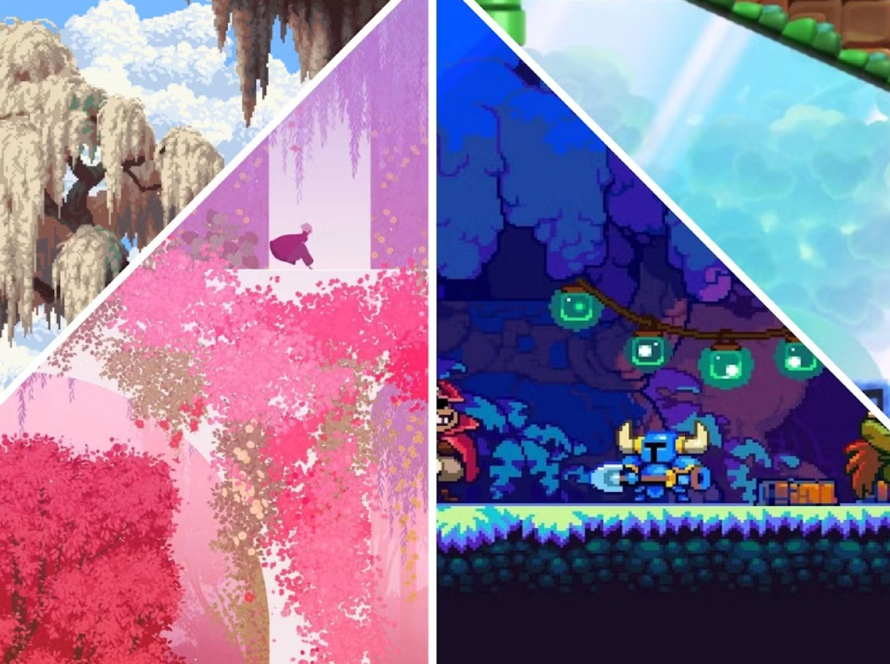Follow us to explore The Role of Vector Graphics in 2D Game Art. From there, discover the suitable graphic style for your 2D game.
What is vector graphics in 2D game art?
In 2D game art, vector graphics are utilized to create assets such as characters, objects, backgrounds, and UI components. Instead of using pixel images, vector graphics employ mathematical formulas to determine the shapes and outlines of objects.
Undoubtedly, vector graphics play a crucial role in 2D game art. Notably, it allows vector assets to be stretched without losing detail and sharpness, providing adaptability to various screen resolutions.
Furthermore, this graphical style also brings several advantages over raster graphics. To delve into the specific roles and benefits of vector graphics in 2D game art, let’s proceed to the section below.
The role of vector graphics in 2D game art
Here are some key aspects that highlight the role of vector graphics in 2D game art:
Scalability across various resolutions
One of the primary roles of vector graphics is their scalability. Unlike raster graphics, which consist of a fixed number of pixels, vector graphics rely on mathematical equations to define shapes and lines. This means that vector images can be scaled up or down without compromising the quality of the image or causing pixelation. Simply put, they can be freely and infinitely stretched without breaking the image.
Whether the game is being played on a small mobile screen or a large desktop monitor, vector graphics ensure that the artwork remains crisp and sharp. Therefore, they become ideal for games playable on different screen sizes and resolutions.
Providing clear outlines in 2D game art
Furthermore, vector graphics are renowned for their smooth and distinct outlines. Artists can craft precise and well-defined shapes using vector illustration software such as Adobe Illustrator or Inkscape. This proves especially beneficial when designing characters, objects, and user interface elements in games, as it ensures visually crisp and appealing images.
Efficient storage in 2D game
In comparison to raster graphics, vector graphics have smaller file sizes. The reason lies in the fact that vector files store mathematical equations describing shapes and lines instead of individual pixel data. This opens the door to efficient storage, reducing the strain on storage resources.
Furthermore, due to the reduced file size, downloading the game and its content happens more quickly. This ensures that players don’t have to endure long waiting times to start playing and immerse themselves in the 2D gaming experience.
Bringing flexibility to 2D game artists
Next, high editability is a crucial advantage of vector graphics. This supports a flexible development and design process. Specifically, artists can easily make modifications by adjusting anchor points, changing colors, resizing elements, or applying various effects. This flexibility allows for quick iterations and modifications during the game development, saving time and effort
Enabling 2D Game Animation
Finally, vector graphics are highly suitable for creating animation content in 2D games. By defining keyframes and interpolating between them, artists can easily produce smooth and fluid dynamic images. Since vector graphics are based on mathematical equations, transforming and animating objects becomes straightforward, making vector-based animation a popular choice in the gaming industry.
FAQs
Explore additional questions and answers related to vector graphics to gain a broader perspective.
Is vector graphics the best approach for my 2D game?
Even though vector graphics serve various essential roles, opting for them in 2D games might not always be the optimal decision. Prior to making a choice between vector and raster graphics for your game, take into account the graphical requirements, art style, and resource constraints. If your game has straightforward graphic needs and necessitates adaptable resizing, vector graphics could be a viable option. Conversely, if your game requires intricate and detailed graphics, raster graphics might prove more fitting.
What are vector graphics used for in games?
With its diverse set of roles mentioned earlier, vector graphics serve various purposes in game development. Here are some common applications of vector graphics in the gaming industry:
- Crafting User Interfaces (UI) for 2D games across different mobile devices.
- Designing characters for 2D games.
- Creating illustrations and images.
- Adding special effects.
- Implementing animation in 2D mobile games.
As emphasized before, it’s important to acknowledge that vector graphics may not always be the best choice for all graphic requirements in games. In certain scenarios, raster graphics (bitmap) might be more suitable for creating detailed and intricate images.
When should you use vector graphics?
You can rely on the roles and advantages of the aforementioned vector graphics to make decisions regarding the use of vector graphics. For example, in a 2D action-adventure game, you aim to create a main character capable of moving flexibly and smoothly on the screen. In this scenario, using vector graphics for animating the character allows you to adjust frames and movements more easily than raster graphics.
Furthermore, you want to display images of characters and items on screens with different resolutions. Using vector graphics for characters and items enables you to scale them easily without blurring or distorting the images. Certainly, in terms of roles, vector graphics provide even more support.
What is a disadvantage of vector graphics?
Despite its outstanding advantages, vector graphics also come with some notable drawbacks. Specifically, they face limitations in representing complex details and rich graphic effects. Because vector graphics rely on geometric shapes and lines, they are unable to reproduce small details, intricate lighting effects, shadows, or sophisticated image techniques typically associated with 3D models.
In Conclusion
In essence, vector graphics play a crucial role in 2D Game art. Therefore, you can leverage them to create high-quality game art, aligning with the overall goals of your 2D game. If you have any needs related to 2D game art, do not hesitate to reach out to us for the quickest support. Thank you for following our article.




